Provo, Utah
Provo (/ˈproʊvoʊ/ PROH-voh) is the fourth-largest city in Utah, United States. It is 43 miles (69 km) south of Salt Lake City along the Wasatch Front. Provo is the largest city and county seat of Utah County and is home to Brigham Young University (BYU).[7]
Provo, Utah | |
|---|---|
| City of Provo | |
 Downtown Provo | |
.png.webp) Flag | |
| Motto: "Welcome Home" | |
 Location within Utah County | |
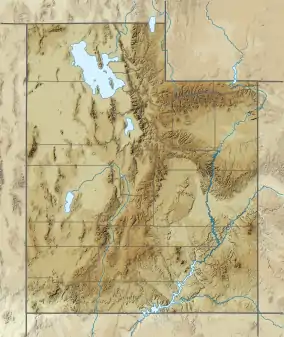 Provo Location within Utah  Provo Location within the United States | |
| Coordinates: 40°14′40″N 111°39′39″W | |
| Country | |
| State | |
| County | Utah |
| Founded | 1849 |
| Incorporated | April 1850 |
| Named for | Étienne Provost[1] |
| Government | |
| • Type | Strong mayor |
| • Mayor | Michelle Kaufusi (R) |
| • Council Chair | David Harding |
| Area | |
| • City | 44.19 sq mi (114.44 km2) |
| • Land | 41.69 sq mi (107.97 km2) |
| • Water | 2.50 sq mi (6.47 km2) |
| Elevation | 4,551 ft (1,387 m) |
| Population | |
| • City | 115,162 |
| • Density | 2,762.34/sq mi (1,066.61/km2) |
| • Metro | 620,000 |
| Time zone | UTC−7 (Mountain (MST)) |
| • Summer (DST) | UTC−6 (MDT) |
| ZIP Codes | 84601-84606 |
| Area codes | 385, 801 |
| FIPS code | 49-62470[5] |
| GNIS ID | 1444661[6] |
| Website | www |
Provo lies between the cities of Orem to the north and Springville to the south. With a population at the 2020 census of 115,162.[3] Provo is the principal city in the Provo-Orem metropolitan area, which had a population of 526,810 at the 2010 census.[8] It is Utah's second-largest metropolitan area after Salt Lake City.
Provo is the home to Brigham Young University, a private higher education institution operated by The Church of Jesus Christ of Latter-day Saints (LDS Church). Provo also has the LDS Church's largest Missionary Training Center (MTC). The city is a focus area for technology development in Utah, with several billion-dollar startups.[9] The city's Peaks Ice Arena was a venue for the Salt Lake City Winter Olympics in 2002. Sundance Resort is 13 miles (21 km) northeast, up Provo Canyon.
In 2015, Forbes cited Provo among the "Best Small And Medium-Size Cities For Jobs,"[10] and the Bureau of Labor Statistics found Utah County had the year's highest job growth.[11] In 2013, Forbes ranked Provo the No. 2 city on its list of Best Places for Business and Careers.[12] Provo was ranked first for community optimism (2012)[13] and first in health/well-being (2014).[14]
History

The Provo area was originally called Timpanogas, a Numic (Ute people) word perhaps meaning "rock river".[15] The area was inhabited by the Timpanogos.[16] It was the largest and most settled area in modern-day Utah.[17] The ample food from the Provo River made the Timpanogos a peaceful people.[16] The area also served as the traditional meeting place for the Ute and Shoshone tribes and as a spot to worship their creator.[18]
Father Silvestre Vélez de Escalante, a Spanish Franciscan missionary-explorer, is considered the first European explorer to have visited the area in 1776. He was guided by two Timpanogos Utes, whom he called Silvestre and Joaquín.[19] Escalante chronicled this first European exploration across the Great Basin Desert. The Europeans did not build a permanent settlement but traded with the Timpanogos, whom they called Lagunas (lake people) or Come Pescado (fish eaters).[17]
In 1847, the Mormon pioneers arrived in the Salt Lake Valley, which was just north of Timpanogos Mountain. At first, the Natives were friendly with the Mormons. But, as relations deteriorated with the Shoshoni and Utes because of disputes over land and cattle, tensions rose. Because of the reported stolen goods of settlers by the Utes, Brigham Young gave small militia orders "to take such measures as would put a final end to their [Indian] depredations in future." This ended in what is known as the Battle Creek massacre, in modern-day Pleasant Grove, Utah.
The Mormons continued pushing into Timpanog lands. In 1849, 33 Mormon families from Salt Lake City established Fort Utah. In 1850, Brigham Young sent an army from Salt Lake to drive out the Timpanogos in what is called the Provo War.[20] Escalating tensions with the Timpanog contributed to the Walker War. Fort Utah was renamed Provo in 1850 for Étienne Provost, an early French-Canadian trapper who arrived in the region in 1825.
In 1850, the first schoolhouse was constructed in Provo, built within Utah Fort.[21]
As more Latter-day Saints arrived, Provo quickly grew as a city. It soon was nicknamed The Garden City with a large number of fruit orchards and gardens there.[22]
In 1872, a railroad reached Provo. It was also this year that the Provo Woolen Mills opened. They were the first large factory in Provo and employed about 150 people, initially mainly skilled textile laborers who had emigrated from Britain.[23]
Geography

Provo lies in the Utah Valley at an elevation of 4,549 feet (1,387 m). According to the United States Census Bureau, the city has an area of 44.2 square miles (114.4 km2), of which 41.7 square miles (107.9 km2) is land and 2.5 square miles (6.5 km2), or 5.66%, is water.[24]
The Wasatch Range contains many peaks within Utah County along the east side of the Wasatch Front. One of them, known as Y Mountain, towers over the city. There is a large hillside letter Y made of whitewashed concrete halfway up the steep mountain, built in the early part of the 20th century to commemorate BYU (original plans included construction use of all three letters). Wild deer (and less frequently, cougars, and moose) still roam the mountains (and occasionally the city streets). The geography allows for hiking, skiing, fishing and other outdoor activities.
Climate
Provo's climate can be classified as either a hot-summer Mediterranean climate classification (Köppen Csa) or as a cool semi-arid climate (Köppen BSk). Overall, annual rainfall at the location of Brigham Young University is around 17.23 inches or 440 millimetres; however, the western part of the metropolitan area near Orem is substantially drier, receiving only around 13.5 inches or 340 millimetres of precipitation and consequently has a cool semi-arid climate (Köppen BSk).[25] The wettest calendar year in Provo has been 1983 with 37.54 inches (953.5 mm) and the driest 2020 with 7.28 inches (184.9 mm).[25]
Winters are cold with substantial snowfall averaging 57.2 inches or 1.45 metres and a record monthly total of 66.0 inches (1.68 m) in January 1918, during which the record snow cover of 34 inches or 0.86 metres was recorded on the 17th. Seasonal snowfall has ranged from 127.5 inches (3.24 m) in 1983–84 to 10.1 inches (0.26 m) in 2014–15. Very cold weather may occur when cold air from over the Continental Divide invades the region: although only four mornings fall to or below 0 °F or −17.8 °C during an average winter and this temperature was not reached at all between 1999 and 2006, during the very cold January 1917 (average temperature 14.9 °F or −9.5 °C), seventeen mornings fell this cold.[25] By contrast, in several recent winters like 1994–95, 1995–96, 1999–2000, 2004–05, and 2005–06, averages have been above freezing every month.
Temperatures warm rapidly during the spring, with the first afternoon over 70 °F or 21.1 °C on March 21, the last freeze expected on April 29, and the first temperature equal to or hotter than 90 °F or 32.2 °C on May 30. Rainfall is not infrequent during the spring: over 5.10 inches or 130 millimetres was recorded in the Mays of 1995 and 2011, and a total of 12.29 inches (312.2 mm) fell during the four-month span of March to June 2005 – in contrast as little as 2.04 inches (51.8 mm) fell in the same months of 2012.[25]
Being too far north to gain any influence from the monsoon except in rare cases like the 4.38 inches (111.3 mm) rainfall of August 1983, Provo's summers are hot and dry, though relatively short – no maxima above 100 °F or 37.8 °C have been recorded outside the range of June 7 to August 27. Monthly maxima average over 91 °F or 32.8 °C in July and August, and precipitation averages under one inch per month with a two-month total in 2016 as low as 0.06 inches or 1.5 millimetres. The hottest month on record is July 2003 with a mean of 81.8 °F or 27.7 °C, and a mean maximum of 99.0 °F or 37.2 °C. The hottest temperature on record is 108 °F (42.2 °C) on July 13, 2002.[25]
The fall season sees steady cooling and a transition to winter weather, with rare influences of rain systems from further south, as in the record wet month of September 1982, which saw 6.53 inches (165.9 mm) of total precipitation, including 4.15 inches (105.4 mm) over the last six days from a storm moving from Arizona. The last maximum of 90 °F (32.2 °C) can be expected around September 10, and the first morning below freezing on October 14.[25]
| Climate data for Provo, Utah (BYU campus), 1991–2020 normals, extremes 1916–present | |||||||||||||
|---|---|---|---|---|---|---|---|---|---|---|---|---|---|
| Month | Jan | Feb | Mar | Apr | May | Jun | Jul | Aug | Sep | Oct | Nov | Dec | Year |
| Record high °F (°C) | 63 (17) |
73 (23) |
84 (29) |
89 (32) |
98 (37) |
105 (41) |
108 (42) |
107 (42) |
101 (38) |
90 (32) |
77 (25) |
72 (22) |
108 (42) |
| Mean maximum °F (°C) | 55 (13) |
63 (17) |
74 (23) |
82 (28) |
90 (32) |
99 (37) |
103 (39) |
100 (38) |
94 (34) |
84 (29) |
70 (21) |
58 (14) |
103 (39) |
| Average high °F (°C) | 41.0 (5.0) |
47.5 (8.6) |
58.3 (14.6) |
65.5 (18.6) |
75.5 (24.2) |
87.0 (30.6) |
95.0 (35.0) |
92.7 (33.7) |
82.9 (28.3) |
68.4 (20.2) |
53.0 (11.7) |
41.2 (5.1) |
67.3 (19.6) |
| Daily mean °F (°C) | 32.3 (0.2) |
37.4 (3.0) |
46.3 (7.9) |
52.5 (11.4) |
61.4 (16.3) |
70.9 (21.6) |
78.6 (25.9) |
76.7 (24.8) |
67.3 (19.6) |
54.5 (12.5) |
42.2 (5.7) |
32.7 (0.4) |
54.4 (12.4) |
| Average low °F (°C) | 23.5 (−4.7) |
27.2 (−2.7) |
34.3 (1.3) |
39.5 (4.2) |
47.2 (8.4) |
54.7 (12.6) |
62.1 (16.7) |
60.8 (16.0) |
51.8 (11.0) |
40.7 (4.8) |
31.4 (−0.3) |
24.2 (−4.3) |
41.5 (5.3) |
| Mean minimum °F (°C) | 8 (−13) |
13 (−11) |
22 (−6) |
28 (−2) |
35 (2) |
43 (6) |
53 (12) |
52 (11) |
40 (4) |
28 (−2) |
17 (−8) |
10 (−12) |
5 (−15) |
| Record low °F (°C) | −20 (−29) |
−20 (−29) |
0 (−18) |
12 (−11) |
27 (−3) |
29 (−2) |
35 (2) |
39 (4) |
21 (−6) |
11 (−12) |
3 (−16) |
−30 (−34) |
−30 (−34) |
| Average precipitation inches (mm) | 1.95 (50) |
1.59 (40) |
1.55 (39) |
1.95 (50) |
1.97 (50) |
0.93 (24) |
0.51 (13) |
0.77 (20) |
1.24 (31) |
1.59 (40) |
1.39 (35) |
1.81 (46) |
17.23 (438) |
| Average snowfall inches (cm) | 12.5 (32) |
8.5 (22) |
4.0 (10) |
3.1 (7.9) |
0.2 (0.51) |
0 (0) |
0 (0) |
0 (0) |
0 (0) |
0.6 (1.5) |
4.5 (11) |
12.0 (30) |
45.4 (114.91) |
| Average precipitation days (≥ 0.01 in) | 10 | 9 | 9 | 10 | 9 | 6 | 5 | 5 | 6 | 7 | 8 | 9 | 93 |
| Average snowy days (≥ 0.1 in) | 6 | 4 | 3 | 2 | 0 | 0 | 0 | 0 | 0 | 0 | 3 | 6 | 24 |
| Percent possible sunshine | 50 | 55 | 67 | 69 | 71 | 80 | 73 | 79 | 83 | 73 | 50 | 56 | 67 |
| Average ultraviolet index | 2 | 3 | 5 | 7 | 9 | 10 | 10 | 9 | 7 | 4 | 3 | 2 | 6 |
| Source 1: NOAA[25] | |||||||||||||
| Source 2: Weather Atlas [26] | |||||||||||||
Demographics
| Historical population | |||
|---|---|---|---|
| Census | Pop. | %± | |
| 1860 | 2,030 | — | |
| 1870 | 2,384 | 17.4% | |
| 1880 | 3,432 | 44.0% | |
| 1890 | 5,159 | 50.3% | |
| 1900 | 6,185 | 19.9% | |
| 1910 | 8,925 | 44.3% | |
| 1920 | 10,303 | 15.4% | |
| 1930 | 14,766 | 43.3% | |
| 1940 | 18,071 | 22.4% | |
| 1950 | 28,937 | 60.1% | |
| 1960 | 36,047 | 24.6% | |
| 1970 | 53,131 | 47.4% | |
| 1980 | 74,108 | 39.5% | |
| 1990 | 86,835 | 17.2% | |
| 2000 | 105,166 | 21.1% | |
| 2010 | 112,488 | 7.0% | |
| 2020 | 115,162 | 2.4% | |
| U.S. Decennial Census[27] | |||
2010 census
At the 2010 census,[5] 112,488 people, 31,524 households and 21,166 families resided in the city. The population density was 2,697.6 inhabitants per square mile (1,041.5/km2). The racial makeup of the city was 84.8% White, 0.7% Black or African American, 0.8% American Indian, 2.5% Asian, 1.1% Pacific Islander, 6.6% from other races, and 3.4% from two or more races. Hispanic or Latino of any race were 15.2% of the population.
There were 31,524 households, of which 34.8% had children under 18 living with them, 55.4% were married couples living together, 8.2% had a female householder with no husband present, and 32.9% were non-families. 12.8% of all households were made up of a single individual, and 4.7% had someone living alone who was 65 years of age or older. The average household size was 3.24, and the average family size was 3.41.
22.3% of residents are under 18, 36.4% are from 18 to 24, 24.8% are from 25 to 44, 10.5% from 45 to 64, and 5.8% who were 65 years of age or older. The median age was 23.3 years. For every 100 females, there were 98.2 males. For every 100 females aged 18 and over, there were 96.4 males.
2000 census
At the 2000 census,[5] 105,166 people, 29,192 households and 19,938 families resided in the city. The population density was 2,653.2 inhabitants per square mile (1,024.4/km2). There were 30,374 housing units at an average density of 766.3/sq mi (295.9/km2). The racial makeup of the city was 88.52% White, 0.46% Black or African American, 0.80% American Indian, 1.83% Asian, 0.84% Pacific Islander, 5.10% from other races, and 2.44% from two or more races. Hispanic or Latino of any race were 10.47% of the population.
There were 29,192 households, of which 33.8% had children under 18 living with them, 57.0% were married couples living together, 7.8% had a female householder with no husband present, and 31.7% were non-families. 11.8% of all households were made up of a single individual, and 4.6% had someone living alone who was 65 years of age or older. The average household size was 3.34, and the average family size was 3.40.
22.3% of residents were under 18, 40.2% from 18 to 24, 23.2% from 25 to 44, 8.6% from 45 to 64, and 5.7% were 65 years of age or older. The median age was 23 years. For every 100 females, there were 92.6 males. For every 100 females aged 18 and over, there were 89.3 males.
The median household income was $34,313, and the median family income was $36,393. Males had a median income of $32,010 and females $20,928. The per capita income was $13,207. About 12.5% of families and 26.8% of the population were below the poverty line, including 14.4% of those under age 18 and 4.3% of those aged 65 or over.
The residents of Provo are predominantly members of the Church Of Jesus Christ OF Latter Day Saints. According to data taken in 2000 by the ARDA, 88% of the overall population, and 98% of religious adherents in the Provo-Orem area are Latter-day Saints.[28] According to a study in 2015, the Provo-Orem metro area is about as dissimilar to the rest of America as possible. Weighing factors such as race, housing, income, and education, the study ranked Provo-Orem 376th of 381 of the United States' largest cities in terms of resemblance to the country.[29]
Religion
The breakdown in 2010 for Utah County was as follows:[30] Most people (90.6%) were Christian, with Latter-day Saints constituting 88.7% of the population. Catholics constituted 1.3% and Protestants constituted 0.6%. Other religions constituted 0.3% of the population. 9.1% of the population did not adhere to any religion.
Economy
Local companies
Provo has more than 100 restaurants (with over 60 in the downtown area)[31] and a couple of shopping centers. The Shops At Riverwoods and Provo Towne Centre, both shopping malls, operate in Provo. Several small shops, music venues, and boutiques have popped up downtown, along Center Street and University Avenue. Downtown has also begun to host "gallery strolls" every first Friday of the month that features local artists. There are many dining establishments in and around downtown Provo.
Five Provo companies are listed on Inc.com's Inc. 5000 list of the fastest-growing private companies in the United States. The largest, DieCuts With a View, is ranked number 1403 and has revenues of $26.2 million.[32] Other companies on the list are VitalSmarts (ranked 4109, with $41.4 million in revenue),[33] and Connect Public Relations (ranked 3694, with $6.1 million in revenue).[34] The global recreation and entertainment company Ryze Trampoline Parks, with locations throughout Asia, Europe and the U.S., is headquartered in Provo.[35]
Novell, the dominant personal computer networking company from the mid-1980s through the mid-1990s, was headquartered in Provo and occupied several buildings at the height of its success. It was eventually acquired by The Attachmate Group and then by Micro Focus, which still maintains facilities there.
The Food & Care Coalition is a local organization providing services to the homeless and low-income citizens of Provo and Utah Counties. They also provide volunteer opportunities.
International companies

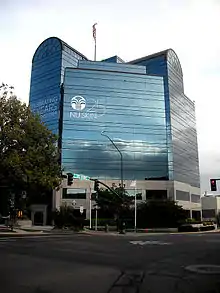
- Action Target, a shooting range manufacturer.
- Aquaveo is a water modeling software company.
- Morinda Bioactives (formerly Tahitian Noni International) is a multi-level marketing health and skin care manufacturer whose products are based on the Tahitian fruit called noni.
- North American Arms, a firearms manufacturer.
- Nu Skin Enterprises, a multi-level marketing firm for skin care products, was founded in 1984.
- Qualtrics, a private research software company.
- Vivint (formerly APX Alarm Security Solutions) is a residential security company with customers.
Top employers
According to Provo's 2019 Comprehensive Annual Financial Report,[36] the top employers in the city were:
| # | Employer | # of Employees |
|---|---|---|
| 1 | Brigham Young University | 5,000-6,999 |
| 2 | Utah Valley Regional Medical Center | 3,000-3,999 |
| 3 | Vivint | 3,000-3,999 |
| 4 | Arm Security | 1,000-1,999 |
| 5 | Revere Health | 1,000-1,999 |
| 6 | Chrysalis Utah | 1,000-1,999 |
| 7 | Qualtrics | 1,000-1,999 |
| 8 | RBD Acquisition | 1,000-1,999 |
| 9 | Frontier Communications | 500-999 |
| 10 | Nu Skin International | 500-999 |
Arts and culture
Annual cultural events
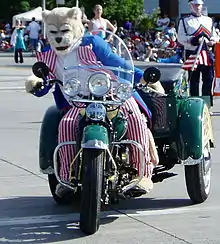
Every July, Provo hosts America's Freedom Festival at Provo which includes the Stadium of Fire at BYU. It is held in LaVell Edwards Stadium, home to BYU's NCAA football team. The Independence Day festivities are popular among residents and have featured such notable figures as Bob Hope, David Hasselhoff, Reba McEntire, Mandy Moore, Huey Lewis and the News, Toby Keith, Sean Hannity, Fred Willard, and Taylor Hicks.[37] In 2015, the event included performances by Journey and Olivia Holt, and was hosted by television personality Montel Williams.[38][39]
Provo has two other large festivals each fall. Festival Latinoamericano is an annual family-oriented Labor Day weekend event in downtown Provo that offers the community a taste of the region's Hispanic culture through ethnic food, vendors, and performances.[40]
The city has hosted an annual LGBT Provo Pride Festival since 2013.[41]
Points of interest
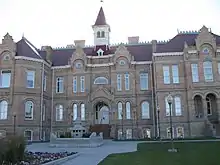
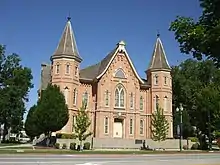
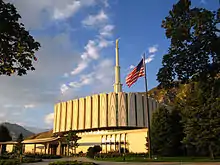

Covey Center for the Arts
The Covey Center for the Arts,[42] a performing arts center, is at 425 West Center Street. It features plays, ballets, art showcases, and musical performances throughout the year. The size of the building is 42,000 total square feet. The main performance hall seats 670 people. Three dance studios are furnished with a piano, ballet bars, and mirrors. Another theater, the Brinton Black Box Theater, seats 60 for smaller, more intimate events. There are also two art galleries: the 1,620-square-foot Secured Gallery and the Eccles Gallery in the lower lobby.[43]
LDS Church Missionary Training Center
Provo is the location of the church's largest missionary training center. Each week approximately 475 missionaries enter for 3–9 weeks of training before they depart for the mission field, becoming part of more than 58,000 in more than 120 countries. About 1,100 instructors (many of them returned missionaries) teach 62 languages. The MTC in Provo began construction in July 1974 and was completed in July 1976. The MTC was expanded in the early 1990s to become the largest of the 17 such centers than in the world.[44][45] Additional construction was completed in 2017.[46][47]
Provo City Library at Academy Square
The Provo City Library is a public library that occupies the building of the former Brigham Young Academy, built-in 1892. The building was added to the National Register of Historic Places in 1976. Its collection contains over 277,000 media. The library is on University Avenue and 550 North.
Provo Recreation Center
With construction finished in 2013, the center provides a location for aquatic recreation next to the Provo Power plant.[48]
Provo Utah Temple
The Provo Utah Temple is at the base of Rock Canyon in Provo. This temple is among the busiest in the LDS Church due to its proximity to BYU and the MTC.[49]
Provo City Center Temple
Located at the corner of University Avenue and Center Street, the Provo City Center Temple serves as another temple for the Provo area's Latter-day Saint population. After a fire in 2010 destroyed the Provo Tabernacle,[50] Thomas S. Monson, then LDS Church president, announced the site would become the city's second temple.[51] Renovations were finished and the temple was dedicated in March 2016.[52]
Utah Valley Convention Center
The Utah Valley Convention Center opened in 2012.[53] It has 83,578 square feet of combined meeting, pre-function and garden space.[54]
Lakeside Storage and Museum
Lakeside Storage and Museum is the largest Petroliana Museum of its kind in the World. It has more original porcelain Gas/Oil signs posted on poles than any other collection. The Museum includes the oldest Brands of gas and oil begun in Utah in 1908, known as the Utah Oil Refining Company and later revised to UTOCO. The museum also includes antique gas pumps, airplanes, antique cars, and fuel delivery vehicles, as well as a Steam-powered and other powered antique tractor collection. It is a free, family-friendly, and photo-friendly site to visit next to Utah Lake State Park in Provo.
Other points of interest

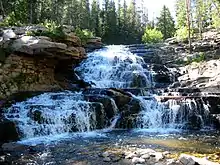
- Bridal Veil Falls (Utah), Provo Canyon, Utah County, Utah - A scenic waterfall 10 miles Northeast of Provo
- Brigham Young University Arboretum
- BYU Museum of Paleontology
- LaVell Edwards Stadium - home of the NCAA college football BYU Cougars as well as Stadium of Fire, an annual 4th of July fireworks show and concert
- The Marriott Center - home of the NCAA college basketball BYU Cougars. The Marriott Center is also used for large university gatherings, such as devotionals, guest lectures, and graduation ceremonies
- (Mount Timpanogos) Timpanogos Peak - the mountain forms the northern horizon of Provo
- Peaks Ice Arena, hockey venue for the 2002 Winter Olympic Games
- The Provo River, a river known for fishing and the Provo River Parkway, a paved bicycle and walking trail adjacent to the river[55]
- Reed O. Smoot House, a National Historic Landmark, at 183 East 100 South
- Seven Peaks Water Park, the largest water park in Utah.[56]
- The Shops At Riverwoods, a center of residences, retail, and entertainment at the mouth of Provo Canyon
- Timpanogos Cave National Monument
- Uinta-Wasatch-Cache National Forest, a national forest on the Wasatch Front bordering the east edge of Provo and Utah Valley
- Utah Lake, a fresh-water lake popular for fishing, boating, and other recreational activities
Government
Federally, Provo is part of Utah's 3rd congressional district, represented by Republican John Curtis, elected in 2017.
City administration
| Elected officials of Provo City as of 2012 | ||
| Official | Position | Term ends |
| Michelle Kaufusi | Mayor | 2018 |
| City Council Members | ||
| David S. Sewell | City Wide I | 2022 |
| George Stewart | City Wide II | 2020 |
| Gary Winterton | District 1 | 2020 |
| George Handley | District 2 | 2022 |
| Dave Knecht | District 3 | 2020 |
| Kay Van Buren | District 4 | 2020 |
| Dave Harding | District 5 | 2022 |
Provo is administered by a seven-member city council and a mayor. Five of the council seats are elected by individual city districts, and two of the seats are elected by the city as a whole. These elected officials serve four-year terms, with elections alternating every two years. Provo has a Mayor–council government, which creates two separate but equal branches of government. The mayor is chief executive of the city and the council is the legislative and policy-making body of the city.[57] The mayor is Michelle Kaufusi, who has been in office since December 5, 2017.
Education
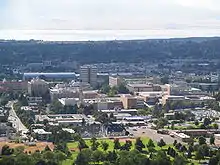

Higher education
BYU is a private university operated by The Church of Jesus Christ of Latter-day Saints. BYU is the third-largest private university in the United States, with more than 34,000 students. It is the flagship of the Church Educational System of higher education. On the campus is the Spencer W. Kimball Tower, the tallest building in Provo.[58][59]
Rocky Mountain University of Health Professions is a private, for-profit university emphasizing graduate healthcare education. The Northwest Commission accredits the university of Colleges and Universities (NWCCU). RMUoHP offers programs in nursing practice, physical therapy, occupational therapy, and health science. RMUoHP will be building Utah County's first new medical school.[60]
Provo College is a private, for-profit educational institution specializing in career education. The school is accredited by the Accrediting Council for Independent Colleges and Schools (ACICS). Provo College offers associate degrees and diplomas in fields such as nursing, medical assisting, criminal justice, graphic design, and office administration.[61]
Primary and secondary education

Almost all of Provo is within the Provo School District.[62] The school board has seven members, each representing a different district of the city. There are thirteen elementary schools, two middle schools, and three high schools. Provo High School was the first school in Utah County to be an IB World school. The school has a record of 4A state basketball championships, more state champions than any other school in the state.[63] Timpview High School has a record of 4A state football championships.
A small section of land in the city coincides with the Alpine School District.[62]
Transportation


Interstate 15 runs through western Provo, connecting it with the rest of the Wasatch Front and much of Utah. US-89 runs northwest to southeast through the city as State Street, while US-189 connects US-89 with I-15, BYU, and Orem to the north. At the north edge of the city, US-189 heads northeast into Provo Canyon, where it connects with Heber.
Amtrak, the national passenger rail system, provides service to Provo station, operating its California Zephyr daily in both directions between Chicago, Illinois, and Emeryville, California (in the San Francisco Bay Area). Provo also can be accessed by Salt Lake Express intercity buses and the extensive Utah Transit Authority (UTA) bus system. UTA's commuter rail service, the FrontRunner, opened an extension to Provo from Salt Lake City on December 10, 2012.[64] The Provo Intermodal Center, adjacent to the Amtrak station, connects the FrontRunner with local bus routes, as well as Greyhound service.
The Provo Municipal Airport is Utah's second busiest airport regarding the number of aircraft take-offs and landings.[65] Allegiant Airlines offers commercial service to Phoenix, Los Angeles, and Tucson. Salt Lake City International Airport is the closest international airport.
People
Provo is home to (or the hometown of) many well-known people, including The Osmonds (including Donny, Marie, and the Osmond Brothers),[66] LDS Church apostle Dallin H. Oaks, and NFL and BYU quarterback Steve Young.[67] Robert Redford also maintains a home at the nearby Sundance Resort, just up Provo Canyon. Goodwin Knight, who served as the 35th Governor of California (1947–1953), was born in Provo. The global economist Dambisa Moyo moved to Provo following her marriage to Qualtrics co-founder Jared Smith.[68]
See also
- List of cities and towns in Utah
References
- Van Atta, Dale (January 22, 1977). "You name it - there's a town for it". Deseret News. Salt Lake City: Deseret Digital Media. p. W6. Retrieved October 18, 2015.
- "2019 U.S. Gazetteer Files". United States Census Bureau. Retrieved August 7, 2020.
- U.S. Census Bureau 2010 Population
- "US Census QuickFacts". Archived from the original on January 23, 2016.
- "U.S. Census website". United States Census Bureau. Retrieved January 31, 2008.
- "Provo". Geographic Names Information System. United States Geological Survey, United States Department of the Interior.
- "25 Fun Things to Do in Provo, Utah". VacationIdea.com. August 14, 2021. Retrieved August 24, 2021.
- "2010 Census Redistricting Data (Public Law 94-171) Summary File". 2010 Census. United States Census Bureau, Population Division. Retrieved February 5, 2011.
- "The street in Provo that's home to three billion-dollar tech companies". Pando. July 25, 2013. Archived from the original on April 17, 2021. Retrieved April 1, 2016.
- "The Best Small And Medium-Size Cities For Jobs 2015". Forbes.
- "Utah County, Utah, has largest over-the-year percent gain in employment, June 2015". US Bureau of Labor Statistics. December 28, 2015.
- "Best Places For Business and Careers - Forbes". Forbes. Retrieved January 13, 2014.
- "Provo-Orem, Utah, Leads U.S. Metro Areas in City Optimism". Gallup. March 2012. Retrieved February 12, 2014.
- "Provo-Orem, Utah, Leads U.S. Communities in Well-Being". Gallup.com. March 25, 2014. Retrieved April 14, 2014.
- Bright, William (2004). Native American Placenames of the United States. University of Oklahoma Press. p. 495. ISBN 978-0-8061-3598-4. Retrieved February 10, 2019.
- "Chapter Five - The Northern Utes of Utah". Archived from the original on May 8, 2016. Retrieved July 25, 2016.
- Virginia McConnell Simmons (May 18, 2011). Ute Indians of Utah, Colorado, and New Mexico. ISBN 9781457109898.
- Peter Gottfredson. Indian Depredations in Utah. Archived from the original on January 21, 2018. Retrieved December 17, 2018.
- "Joaquin Neighborhood Plan pg. 3 :: City of Provo". Archived from the original on February 25, 2021. Retrieved January 19, 2017.
- "Utah Historical Quarterly Volume XLVI :: Utah State Historical Society - Historic and Prehistoric Publications". Archived from the original on August 17, 2016. Retrieved July 23, 2016.
- Provo Library timeline of Provo
- Utah.com history of Provo
- "Utah History to Go article on Provo". Archived from the original on March 17, 2018. Retrieved May 27, 2018.
- "Geographic Identifiers: 2010 Demographic Profile Data (G001): Provo city, Utah". United States Census Bureau. Retrieved March 8, 2012.
- "NowData - NOAA Online Weather Data". National Oceanic and Atmospheric Administration. Retrieved February 14, 2012.
- "Provo, Utah, USA - Monthly weather forecast and Climate data". Weather Atlas. Retrieved July 4, 2019.
- "Census of Population and Housing". Census.gov. Retrieved June 4, 2015.
- "Religious adherents in Provo-Orem, Utah". Thearda.com. Archived from the original on October 21, 2013. Retrieved February 12, 2014.
- Amy Mcdonald (June 24, 2015). "Provo-Orem is least American area in Utah, study says". The Salt Lake Tribune. Archived from the original on May 4, 2016. Retrieved May 8, 2016.
- "U.S. Religion Census: Religious Congregations and Membership Study, 2010 (County File)". thearda.com. Retrieved February 19, 2018.
- "Businesses". DowntownProvo.org. Retrieved April 28, 2017.
- "DieCuts With a View". Inc. Archived from the original on January 26, 2013. Retrieved October 7, 2008.
- "VitalSmarts". Inc. Archived from the original on October 21, 2014. Retrieved October 7, 2008.
- "Connect Public Relations". Inc. Archived from the original on January 26, 2013. Retrieved October 7, 2008.
- Bethany Clough, "Skywalk trampoline arena opens today in Made," Archived February 12, 2015, at the Wayback Machine, The Fresno Bee, October 19, 2011. Retrieved February 10, 2015.
- City of Provo (2019). "Annual Financial Report". Archived from the original on October 3, 2020.
- "Taylor Hicks at Stadium of Fire 2006". Deseret News. Archived from the original on November 27, 2007. Retrieved February 12, 2014.
- "Journey to headline Provo's Stadium of Fire show this July 4". The Salt Lake Tribune.
- "Journey to headline Stadium of Fire 2015; Disney Channel's Olivia Holt will Perform; TV icon Montel Williams to Host". freedomfestival.org. Archived from the original on January 16, 2016. Retrieved January 3, 2016.
- "Festival Latinoamericano official website". Festivalprovo.com. Archived from the original on August 9, 2013. Retrieved February 12, 2014.
- "Provo Pride – Provo Pride Fest boosts LGBT visibility in Mormonism's 'Happy Valley'". provopride.org. Archived from the original on June 16, 2016. Retrieved June 28, 2016.
- "Covey Center for the Arts". Covey Center for the Arts. Archived from the original on October 21, 2013. Retrieved February 12, 2014.
- "Covey Center for the Arts facts". Covey Center for the Arts. Archived from the original on November 7, 2013. Retrieved February 12, 2014.
- Robb Hicken (December 1, 2005). "BYU helps push language learning for missionaries". BYU NewsNet. Archived from the original on September 3, 2006. Retrieved November 9, 2006.
- "LDS Newsroom - Statistics of LDS Church". Archived from the original on August 10, 2010.
- Lockhart, Ben (July 26, 2017). "New MTC buildings in Provo include larger classrooms, outside study space". Deseret News. Retrieved August 14, 2020.
- Hanks, Bethany (July 26, 2017). "LDS Church releases photos, videos of expanded MTC". Deseret News. Retrieved August 14, 2020.
- "City of Provo, UT : Recreation Center".
- "Utah Valley/Provo Area Mormon History Sites". Utah.com. Archived from the original on September 5, 2008. Retrieved October 7, 2008.
- Reavy, Pat (December 18, 2010). "Provo Tabernacle burns in four-alarm fire". Deseret News. Archived from the original on October 29, 2019. Retrieved October 29, 2019.
- Armstrong, Caleb. "2011: Provo City Center Temple announcement". Daily Herald. Archived from the original on October 29, 2019. Retrieved October 29, 2019.
- Walch, Tad (March 20, 2016). "Elder Oaks dedicates Provo City Center Temple as 150th temple of the LDS Church". Deseret News. Archived from the original on October 29, 2019. Retrieved October 29, 2019.
- "Construction of Utah County Convention Center gets under way". Deseret News. June 15, 2010. Archived from the original on October 21, 2013. Retrieved August 6, 2010.
- "ABOUT US". Utah Valley Convention Center. Archived from the original on May 30, 2016. Retrieved May 14, 2016.
- "Provo River Parkway". Utahcountyonline.org. Archived from the original on July 11, 2011. Retrieved April 1, 2011.
- "Seven Peaks Water Park". Sevenpeaks.com. Archived from the original on November 1, 2015. Retrieved February 12, 2014.
- "Provo Government Format". Blogspot.Com. 2009. Archived from the original on October 21, 2013. Retrieved May 1, 2012.
- "Kimball Tower". Emporis. Archived from the original on May 25, 2007. Retrieved April 7, 2007.
- "Campus Information". Brigham Young University. Archived from the original on December 10, 2005. Retrieved April 7, 2007.
- "Utah County to be site of new medical school". The Daily Herald. Archived from the original on October 1, 2016. Retrieved October 1, 2016.
- "Utah College Programs - Provo College - Provo & American Fork, Utah". Provo College. Archived from the original on October 18, 2012. Retrieved February 12, 2014.
- "2020 CENSUS - SCHOOL DISTRICT REFERENCE MAP: Utah County, UT" (PDF). U.S. Census Bureau. pp. 2-3 (PDF p. 3-4/7). Retrieved October 17, 2022.
- "Utah High School Sports Records". Deseretnews.com. Archived from the original on October 21, 2013. Retrieved February 12, 2014.
- "FrontRunner South opens, brings changes to north line". KSL.com. December 10, 2012. Archived from the original on February 22, 2014. Retrieved February 12, 2014.
- Davidson, Lee (September 25, 2015). "Provo now Utah's No. 2 airport, passing St. George and Wendover". Salt Lake Tribune.
- "The Osmonds (The Osmond Family) biography". Biography Channel. Archived from the original on September 30, 2007. Retrieved October 7, 2008.
- "Class Acts". ESPN. 2005. Retrieved October 7, 2008.
- "Dambisa Moyo finds love in the US". Lusaka Times. December 29, 2020. Retrieved December 29, 2020.
- Archived October 21, 2013, at the Wayback Machine
- "City of Provo, UT : Sister Cities". Archived from the original on April 13, 2015. Retrieved May 6, 2015.
External links
- Official website
- Provo historical images at the Harold B. Lee Library, Brigham Young University
- Aerial view of Provo, Utah, MSS SC 2962 at L. Tom Perry Special Collections, Harold B. Lee Library, Brigham Young University
- "Provo, Utah". C-SPAN Cities Tour. July 2016.

